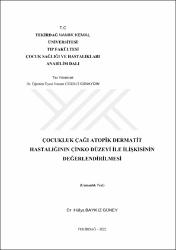| dc.contributor.advisor | Günaydın, Nurşen Ciğerci | |
| dc.contributor.author | Güney, Hülya Baykız | |
| dc.date.accessioned | 2022-04-06T06:49:28Z | |
| dc.date.available | 2022-04-06T06:49:28Z | |
| dc.date.issued | 2021 | |
| dc.identifier.uri | https://tez.yok.gov.tr/UlusalTezMerkezi/TezGoster?key=8tbPippmWV_b-Irrn9YEAtH7VcNpdIdph35g_FRncdLHU0gdJ5vwrqMwUzZL57wl | |
| dc.identifier.uri | https://hdl.handle.net/20.500.11776/4123 | |
| dc.description.abstract | Çinko eksikliğinin atopik dermatit immünopatogenezi ile ilişkili olduğu düşünülmektedir. Atopik dermatit tanılı çocuklarda çinko düzeylerinin sağlıklı kontrol grubuyla karşılaştırılarak değerlendirilmesi ve atopik dermatit tanılı çocuklarda çinko düzeyinin hastalık şiddeti, klinik bulgular ve laboratuvar parametreleri ile ilişkisinin değerlendirilmesi çalışmamızın amacını oluşturmaktadır. Ayrıca çinko eksikliğini öngörmede maliyeti düşük olan ve rutinde bakılan laboratuvar parametrelerinin kullanımının klinikte yardımcı olacağı düşüncesindeyiz. Çalışmamız prospektif bir olgu-kontrol çalışmasıdır. Atopik dermatit tanısıyla izlenen 72 olgu hasta grubu olarak alındı. Benzer yaş ve cinsiyette çocuk sağlığı ve hastalıkları polikliniğinde izlenen 42 olgu da kontrol grubu olarak alındı. Hasta grubu ve kontrol grubundaki olguların özgeçmiş ve soygeçmiş özellikleri hasta dosyalarından retrospektif olarak kaydedildi. Eritrosit içi çinko değerlerine bakabilmek için EDTA'lı tüpe kan alındı. Tüm olguların yaş ve cinsiyet verileri karşılaştırıldı. AD'li hasta grubundaki olguların eritrosit içi çinko düzeyleri ile PDW değerleri arasında negatif korelasyon olduğu tespit edildi. Çalışmaya katılan AD'li hastalardan çinko eksikliği olanlarda PDW ve WBC değerlerinin daha yüksek olduğu saptandı. Hastaların NLR değerleri ise çinko eksikliği olmayan grupta daha yüksekti. Çalışmamızdaki olguların yaşı büyüdükçe çinko düzeyinin arttığı görüldü. Sonuç olarak çinko eksikliği sıklığının yaş ile azaldığı saptandı. Hasta grubu ile kontrol grubu arasında İEZn seviyeleri #©karşılaştırıldığında istatistiksel olarak anlamlı fark yoktu ancak İEZn ortalaması AD'li hasta grubunda sayısal anlamda kontrol grubuna oranla daha düşük saptandı. Sonuç olarak çinko düzeyi AD'li hastalarda daha düşük saptandığı için atopik dermatit tanısıyla izlenen olgularda bu elementi değerlendirmek faydalı olabilir. Ancak çinkonun atopik dermatit gelişimindeki ve sürecindeki rolü için daha fazla çalışmaya ihtiyaç duyulmaktadır. | en_US |
| dc.description.abstract | Zinc deficiency is thought to be related to the immunopathogenesis of atopic dermatitis. The aim of our study is to evaluate the zinc levels in children diagnosed with atopic dermatitis by comparing them with the control group and to evaluate the relationship between zinc levels and disease severity, clinical findings and laboratory parameters in children with atopic dermatitis. In addition, we think that the use of laboratory parameters, which are costly and routinely examined, will help the clinic in predicting zinc deficiency. Our study is a prospective case-control study. 72 cases followed up with atopic dermatitis diagnosis were taken as the patient group. 42 cases of similar age and sex who were followed up in the pediatric health and diseases outpatient clinic were included as the control group. The patient's medical and family history characteristics of the patients in the patient group and the control group were recorded retrospectively from the patient files. Blood was taken into an EDTA tube in order to examine the intraerythrocyte zinc values. Demographic data of all cases were compared. The background and family history characteristics of the patients in the patient group and the control group were recorded retrospectively from the patient files. Blood was taken into an EDTA tube in order to examine the intraerythrocyte zinc values. Demographic data of all cases were compared. It was determined that there was a negative correlation between intra-erythrocyte zinc levels and PDW values of the patients in the patient group with AD. Among the patients with AD who participated in the study, those with zinc deficiency were found to have higher PDW and WBC values. NLR values of the patients were higher in the group without zinc deficiency. It was observed that as the age of the patients in our study increased, the zinc level increased. As a result, it was found that the frequency of zinc deficiency decreased with age. When IEZn levels were compared between the patient group and the control group, there was no statistically significant difference, but the mean IEZn in the patient group with AD was numerically lower than the control group. As a result, it may be useful to evaluate this element in cases followed up with the diagnosis of atopic dermatitis, since the zinc level is found to be lower in patients with AD. However, more studies are needed for the role of zinc in the development and process of atopic dermatitis. | en_US |
| dc.language.iso | tur | en_US |
| dc.publisher | Tekirdağ Namık Kemal Üniversitesi | en_US |
| dc.rights | info:eu-repo/semantics/openAccess | en_US |
| dc.subject | Allerji ve İmmünoloji | en_US |
| dc.subject | Allergy and Immunology | en_US |
| dc.subject | Çocuk Sağlığı ve Hastalıkları | en_US |
| dc.subject | Child Health and Diseases | en_US |
| dc.subject | Atopik dermatit | en_US |
| dc.subject | çinko | en_US |
| dc.subject | enflamatuar belirteç | en_US |
| dc.subject | Atopic dermatitis | en_US |
| dc.subject | zinc | en_US |
| dc.subject | inflammatory marker | en_US |
| dc.title | Çocukluk Çağı Atopik Dermatit Hastalığının Çinko Düzeyi ile İlişkisinin Değerlendirilmesi | en_US |
| dc.title.alternative | Çocukluk çaği atopik dermatit hastaliğinin çinko düzeyi ile i?lişkisinin değerlendirilmesi | en_US |
| dc.type | specialistThesis | en_US |
| dc.department | Enstitüler, Tıp Fakültesi, Çocuk Sağlığı ve Hastalıkları Ana Bilim Dalı | en_US |
| dc.identifier.startpage | 1 | en_US |
| dc.identifier.endpage | 89 | en_US |
| dc.institutionauthor | Güney, Hülya Baykız | |
| dc.relation.publicationcategory | Tez | en_US |
| dc.identifier.yoktezid | 674353 | en_US |



















